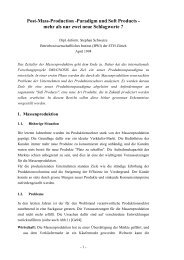The China Venture
The China Venture
The China Venture
You also want an ePaper? Increase the reach of your titles
YUMPU automatically turns print PDFs into web optimized ePapers that Google loves.
<strong>The</strong> apparent policy of the partner company to channel workers to the joint venture affected<br />
also for the distribution system as the partner would sabotage the initially successful efforts to<br />
outsource distribution to a third party.<br />
Problems like these are reported by many companies operating in <strong>China</strong>. Many of these<br />
problems will not be totally avoidable. It is crucial, however, how a company can react in face<br />
of such problems and challenges.<br />
CGC's management was well aware of the problems at an early stage on. After the initial<br />
phase of joint venture foundation was completed, the management's interest in their <strong>China</strong><br />
project did not diminish. This was due to the significance of the venture for the relatively<br />
small and internationally inexperienced company. For this reason as well as the short term<br />
goals of the joint venture, CGC realised very early on that a re -evaluation and subsequent<br />
repositioning of the joint venture was necessary.<br />
<strong>The</strong>re were enough ideas for such a repositioning, ranging from a stop to new employees, to<br />
the outsourcing of distribution. <strong>The</strong> company had also hoped that its contract, capital<br />
majority, and management authority would allow it to alter operational strategy relatively<br />
easily. CGC had to realise, however, that a repositioning within the current structure could not<br />
be achieved. It had not talked with its partner about eventualities that would make massive<br />
changes of the operations of the company necessary. More importantly, CGC realised only<br />
later on that there existed a mismatch of goals between the foreign and Chinese partner, who<br />
seemed to be mostly concerned with cutting down its own work force.<br />
<strong>The</strong>refore, any drive for change met with fierce opposition. Combined with a certain lack of<br />
understanding of local procedures, the working climate deteriorated massively, until CGC had<br />
to realise that the venture had failed entirely. CGC ultimately had lost all of its capital.<br />
Just as in the case of LGC, also CGC failed to provide for the possibility of massive<br />
restructuring and repositioning in the early phases of market entry planning. In their<br />
evaluation of market entry methods, both companies did not give enough weight to the<br />
flexibility that a wholly owned, or de -facto wholly owned company would provide for the<br />
foreign investor. Both companies might have chosen a joint venture agreement even if they<br />
had taken such possibilities into consideration. But by ignoring the possibility of the necessity<br />
of major changes in operational and strategic direction, the companies did not plan their<br />
market entrance in an optimal way.<br />
146






